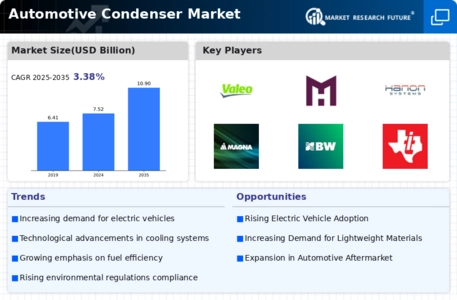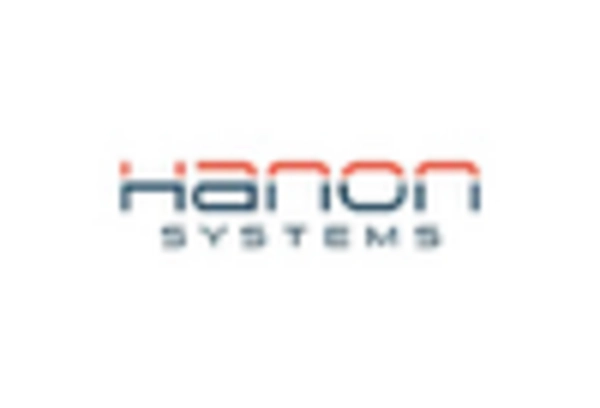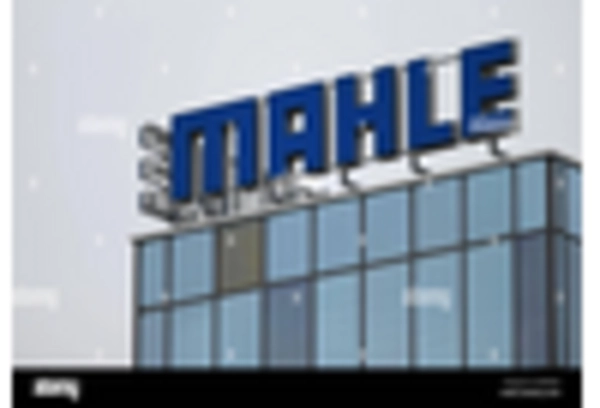Growth in Automotive Production
The Automotive Condenser Market is poised for growth due to the increasing production of vehicles worldwide. Recent statistics indicate that automotive production has seen a steady rise, with millions of units manufactured annually. This surge in production directly correlates with the demand for automotive components, including condensers. As manufacturers ramp up production to meet consumer demand, the need for high-quality condensers becomes paramount. The Automotive Condenser Market is likely to benefit from this trend, as more vehicles on the road translate to a higher demand for replacement parts and new installations. This growth in production not only supports the market but also encourages innovation in condenser technology.
Rising Demand for Fuel Efficiency
The Automotive Condenser Market is experiencing a notable increase in demand for fuel-efficient vehicles. As consumers become more environmentally conscious, manufacturers are compelled to enhance the efficiency of their vehicles. Condensers play a crucial role in the vehicle's cooling system, directly impacting fuel consumption. According to recent data, vehicles equipped with advanced condensers can improve fuel efficiency by up to 15%. This trend is likely to drive innovation in condenser technology, as manufacturers seek to develop lighter and more efficient designs. The push for fuel efficiency is not only a response to consumer preferences but also aligns with broader sustainability goals, thereby propelling the Automotive Condenser Market forward.
Technological Innovations in Cooling Systems
The Automotive Condenser Market is significantly influenced by ongoing technological innovations in vehicle cooling systems. Advances in materials and design are leading to the development of more efficient condensers that enhance overall vehicle performance. For instance, the introduction of microchannel condensers has revolutionized the market by offering improved heat exchange capabilities. These innovations are expected to increase the efficiency of air conditioning systems, thereby enhancing passenger comfort and reducing energy consumption. As manufacturers continue to invest in research and development, the Automotive Condenser Market is likely to witness a surge in demand for these advanced cooling solutions.
Regulatory Compliance and Environmental Standards
The Automotive Condenser Market is significantly impacted by regulatory compliance and environmental standards. Governments worldwide are implementing stricter regulations aimed at reducing emissions and improving vehicle efficiency. These regulations often necessitate the use of advanced cooling systems, including high-efficiency condensers, to meet the required standards. As manufacturers strive to comply with these regulations, the demand for innovative condenser solutions is expected to rise. This trend not only supports the growth of the Automotive Condenser Market but also encourages manufacturers to invest in sustainable practices and technologies, aligning with global efforts to combat climate change.
Increasing Adoption of Advanced Driver Assistance Systems (ADAS)
The Automotive Condenser Market is also being driven by the increasing adoption of Advanced Driver Assistance Systems (ADAS). These systems require efficient thermal management to ensure optimal performance. As vehicles become more technologically advanced, the need for effective cooling solutions, including high-performance condensers, becomes critical. The integration of ADAS in vehicles is expected to grow, leading to a corresponding increase in demand for automotive condensers that can support these systems. This trend indicates a shift towards more sophisticated vehicle designs, which will likely benefit the Automotive Condenser Market as manufacturers seek to meet the cooling requirements of these advanced technologies.


















Leave a Comment